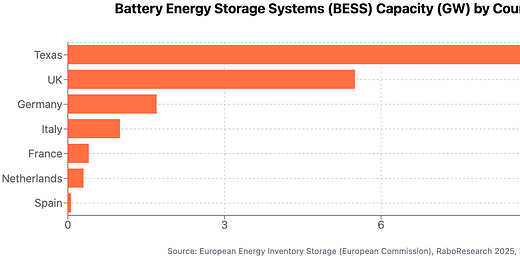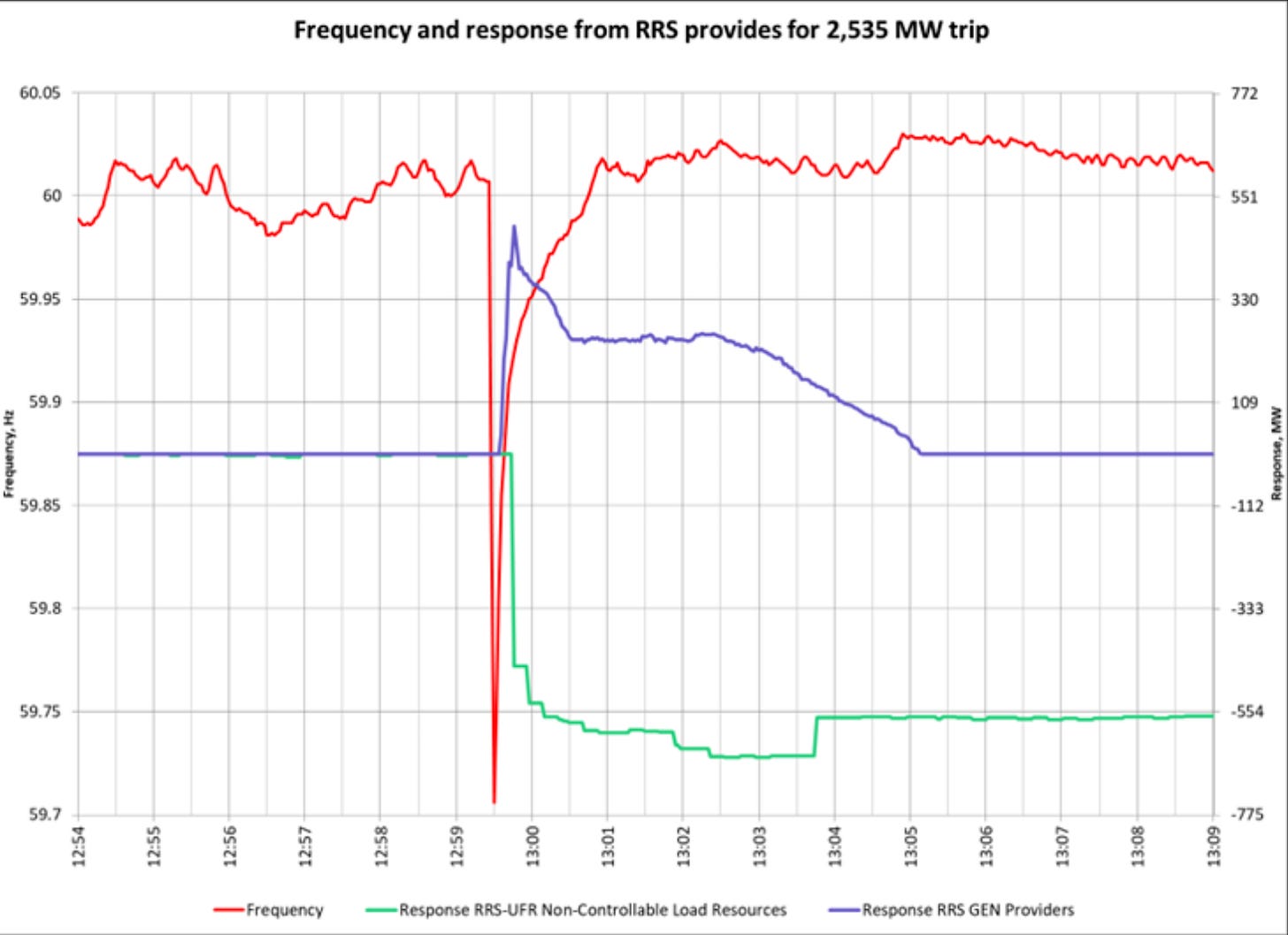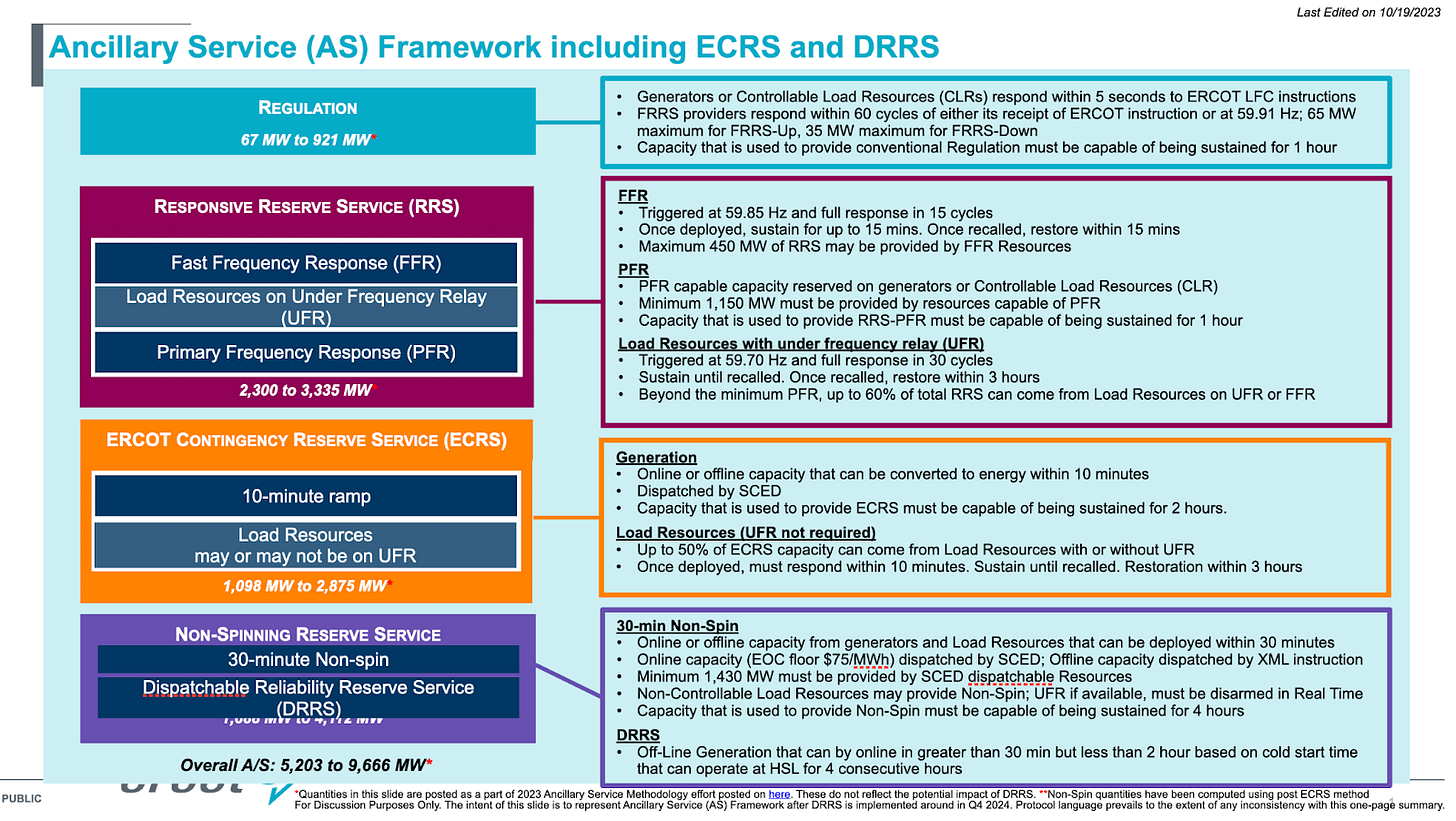BESSt in Class
Massive battery resources and far-sighted ancillary services providing "defense-in-depth" help protect Texas from a Spain-type power outage
First of all, you’re reading this article more than two days after the blackouts in Spain and Portugal. I talked to a lot of experts, read everything I could, and responded — intentionally — slowly.
Unfortunately, too many voices have jumped into the informational void, and way too many of them are filling it with cynical misinformation designed to hurt renewables. They didn’t know what happened on Monday, and they still don’t. This is complicated stuff and will take months to sort out.
It’s worse than unhelpful to use that uncertainty and fear to push a radical anti-energy agenda.
Is Texas prepared for massive, quick frequency deviations?
Unlike a lot of folks, I’m going to stick to what I know: Texas.
More than a decade ago, ERCOT convened the Future Ancillary Services Team (FAST) to prepare for the kind of incident that hit Spain this week (I’ve been doing this long enough that I participated in some of those meetings). That effort led to a new fast-responding backup reserve program that helps ERCOT deal with rapid frequency shifts.
That work is ongoing, and there likely will be lessons to incorporate from this week’s event. But the biggest, which some people are unfortunately trying to drown out, is that Texas can have a reliable and affordable grid that has a lot of renewable power. The answer is not to dump one of the most affordable, quickest-to-build sources of electricity in the world, any more than the response to the 2021 Winter Storm Uri blackouts — which were caused primarily by frozen thermal plants and gas infrastructure — would have been to do away with gas plants.
The answer is to create an effective, affordable, reliable energy portfolio, and to make sure it works. In this case, that starts with battery storage. Spain has only 60 megawatts of battery energy storage systems (BESS). Texas has nearly 200 times that amount: more than 11,000 megawatts.
That can make all the difference.
Batteries are faster than people
When things go bad on a grid, they can go bad very quickly. Response must be almost instant. In Spain, operators apparently had about five seconds to respond to the frequency fluctuation before the entire grid went down.
That’s not enough time for a human to make a decision and execute on it.
But it’s more than enough time for batteries to respond.
ERCOT’s Future Ancillary Service Team spurred creation of a new backup reserve known as FFR, or Fast Frequency Regulation. In Texas, FFR resources respond to frequency deviations in one-fourth of one second. That would’ve been more than enough time to respond to the issues on Monday.
The ERCOT illustration above shows what would happen in Texas during a major frequency deviation (the red line). The blue line shows battery response. The time scale is in seconds: as you see, battery FFR resources jump into action in about a quarter-second when the grid is in trouble.
It appears — and again, caution is warranted here — that Spain wasn’t using these kinds of ultrafast-responding resources. We’ll need a lot more information before we know for sure how quickly their Primary Frequency Response could or did respond but we know they have only 60 megawatts of BESS and Texas has over 11,000.
And that means Texas is much better prepared for these kinds of frequency deviations.
Defense-in-Depth
ERCOT also has actively developed a comprehensive suite of ancillary services — some call it “Defense-in-Depth.”
This approach acknowledges the many, many risks that the ERCOT grid faces, especially with its limited interconnections: thermal generators can trip offline, large loads can drop off suddenly, transmission lines can go down. Yes, renewables have risks, too. And sometimes, multiple problems hit all at once or in a very short period of time.
The key is to have ancillary services respond to those problems, whatever they may be. Texas’s defense starts with FFR, but it doesn’t end there; there are many layers to this defense-in-depth approach:
Grid managers — in Spain and everywhere — need these kinds of tools. More than that, they need a wide view of the potential pitfalls as new forms of energy come onto the grid.
Something as simple as a computer setting on an inverter can cause power plants to drop offline at the same time and disrupt frequency. ERCOT is ahead on this front, too: after lots of input from ERCOT staff and stakeholders, the Board revised the agency’s protocols last year to address exactly this issue.
The point isn’t to demonize or discard a needed energy resource because it might have potential problems — they all have problems. The point, which ERCOT and the PUC understand, is to prepare for those problems in ways that keep the grid running. As Texas PUC Deputy Director Barksdale English put it, “The need for ancillary services are based on risks, not resource types.”
The real questions to answer
There are a couple of critical questions to answer following a major grid event: what were the causes, was the response appropriate or was there human error, and did grid operators have the tools they needed?
We don’t know the answers to the first two of those questions right now with regard to this week’s incident, and we must not predetermine the outcome before a full investigation. We know the answer to the third. We also know ERCOT has been proactive in its preparations going back over a decade and thus Texas has lots of tools — defense-in-depth — to deal with exactly these kinds of incidents.
Let’s definitely not stop Texas’s energy expansion and energy leadership — especially given the reliability and affordability benefits renewables deliver every day — because something we still don’t understand happened in Europe.
Instead, let’s work to expand fast-acting resources — including and especially batteries — to create even more defense in depth while we continue to grow our economy with abundant, affordable, clean energy.
Thank you for reading. This is a free article but your support makes it possible. Please consider becoming a paid subscriber. If you’re already one, thank you!





